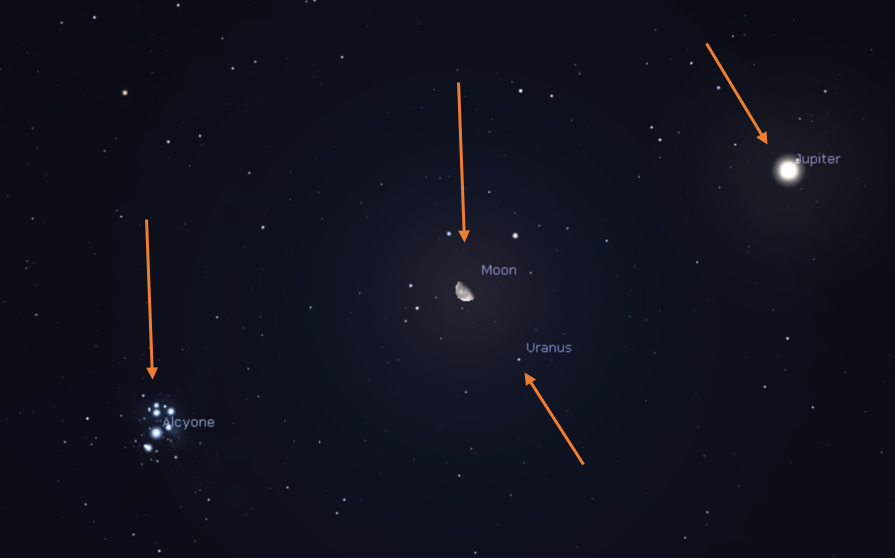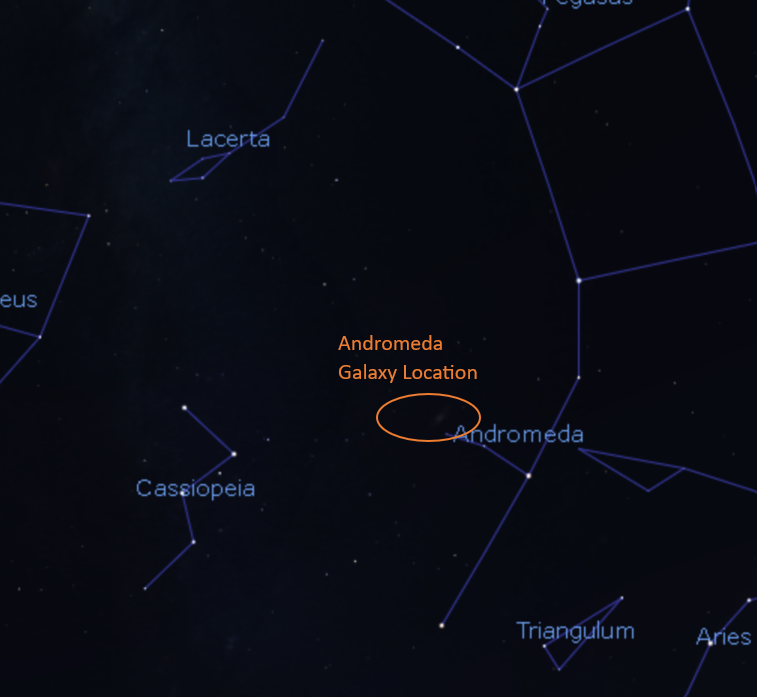What's Up: September 3 - 10, Jared May
It looks like there may be a few clear nights at the beginning and the end of this week, according to the forecast. We are now officially in meteorological fall (not to be confused with astronomical fall which starts September 23rd). The temperatures shortly after sunset will be quite toasty in the upper 70s. Sunset occurs around 7:55 PM this week so have your telescopes set up and ready to look at the sky by 9 PM. Be on the lookout for the third-quarter moon, the Andromeda Galaxy, a brightening comet, and the Eastern Veil Nebula.
Wednesday, September 6th, is the official third-quarter moon. The moon in this phase doesn’t rise until around midnight, so you’ll need to be out stargazing for a while if you have a hope of seeing or photographing it.
The Third Quarter Moon (Simulation made using Stellarium).
On Tuesday, the day before the third quarter, try to catch the waning-gibbous moon sitting directly between Jupiter and a ghost of the winter skies, the Pleiades cluster. The moon will only be 2° above Uranus, but the bright halo of reflected sunlight might make seeing this faint outer planet difficult. A set of binoculars will reveal more than just the “seven sisters” of stars within the Pleiades cluster – how many can you count?
The moon will be halfway between Jupiter and the bright star cluster, The Pleiades, on Tuesday evening.
If you turn your attention to the northern skies, you will spot the constellations of Cassiopeia and Andromeda. Between these two is our galactic neighbor, the Andromeda Galaxy. Most galaxies are difficult to spot since they are small and not very bright. Luckily, Andromeda spans the same length as six full moons and is naked-eye visible in most dark locations. Of course, our eyes cannot see the intricate structure of the spiral arms, which requires a long-exposure camera.
Where to find the Andromeda Galaxy.
A deep photograph of the Andromeda Galaxy. This is not what you’d see with your unaided eye or a telescope. (Stellarium)
A new comet was discovered on August 11, and it is rapidly brightening. Designated as C/2023 P1 Nishimura, the ice ball is closing in on the sun causing the tails to brighten day-by-day. This week between 5 AM and 6:30 AM, look 15° left of Venus to spot the comet, currently shining at magnitude 6. With any luck, this comet will become naked-eye visible within the next few weeks. [photo: https://science.nasa.gov/introducing-comet-nishimura]
Comet C/2023 P3 Nishimura
Last week’s blog mentioned some of the deep-sky objects that can be found within the Cygnus the Swan constellation, including the Veil Nebulae. Taking a bit more of a deep dive, these emission regions can be found in one of the swan’s wings and is broadly called the Cygnus Loop. One of the subregions is called the Eastern Veil Nebula which shines at magnitude 6 but is spread across the same area as two full moons, which decreases its overall surface brightness. This nebula, along with the Western Veil Nebula and other parts of the Cygnus Loop, are all the result of the supernova that happened over 10,000 years ago. The odd shape is caused by the fine features of the supernova’s shockwave that is still expanding outwards at around 930,000mph. The vivid red and blue colors are from ionized hydrogen and oxygen respectively. An oxygen-III narrowband filter can let you see this nebula through a telescope easily. [photo taken from a bortle-4 site using a narrowband filter specific to the hydrogen and oxygen emission to bring out the red and blue colors]
The Eastern Veil nebula, the so-called “network nebula”. [photo taken from a bortle-4 site using a narrowband filter specific to the hydrogen and oxygen emission to bring out the red and blue colors]
Get outside this first week of meteorological fall and enjoy the rather warm twilight and nighttime temperatures. Hopefully, the clear skies will stay in the forecast for later in the week. Bring a comfortable chair or blanket to lie down on for stargazing. It is always humbling to peer up into a sky filled with planets, thousands of nebulae, millions of stars, and billions of galaxies. Perhaps this week you can have that experience by looking for the third-quarter moon passing by the Pleiades and Jupiter, the Andromeda Galaxy, an all-new comet, or the Eastern Veil Nebula.
Clear Skies!





